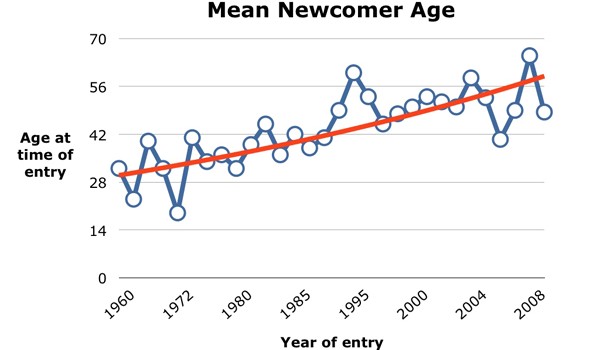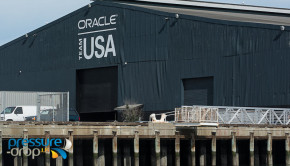Nicholas Hayes – What�s Really Wrong with Yacht Clubs
Published on April 23rd, 2010
 What’s Really Wrong with Yacht Clubs
What’s Really Wrong with Yacht Clubs
By Nicholas Hayes, Author of Saving Sailing
(April 23, 2010) If I had to make a chart to represent hours of fun I’ve had by originating location, it would show that a big slice of my fun begins at a yacht club. So I generally like them a lot.
At the same time, I’ll admit a personal bias towards the idea that yacht clubs should instead call themselves sailing clubs, and the sooner they do it, the better for sailing. For me, it’s not just about marketing: if I never see, smell, hear or feel a power boat again in my life, I’ll be thrilled. And I hate blazers and slacks.
But more than naming conventions and my pet-peeves, yacht clubs are generally in trouble, because their members are dying faster than they can find or make new ones. They need to make a change. I’ve been studying the problem now for almost 20 years; some of my research inspired the book Saving Sailing. Yacht clubs have an age problem: member average age is usually around 60. Of course most clubs have junior programs as a feeder, but they usually don’t feed. I’ve written extensively about how age segregation is part of the problem – it creates a broad chasm between young skilled, eager sailors, and the older, tiring base of a club. Consider these observations, excerpted from the book:
“In most sailing clubs today, the kids show up in the morning, and leave in the late afternoon, just about the time the adults are arriving”
“…the decline in participation in sailing is better explained as a decline in devotion to intergenerational free-time pursuits.”
It is hard to explain why it seems we’ve gone to such lengths to create this gap — separating the generations unnecessarily — accept to suggest that:
1.) it is a passive response to a general trend towards youth-sports and away from intergenerational activities everywhere, because youth-sports are easier to market, coordinate and scale, or…
2.) we’ve come to depend on active, age-specific marketing for everything, and we’re lacking the pop culture hero willing to twitter to inspire both 11 year olds and their moms to try sailing. After all, marketing to parents means marketing to their kids, right?
And then some new data hit my desk, suggesting that it has nothing to do with marketing at all. We have it backwards.
Last month I was planning a Saving Sailing presentation at a 110 year old club, and working with a smart, relatively young (40’s) member of the club’s board of directors to ensure a relevant talk. He suggested that in advance he would survey members to understand age, tenure, interests and value delivered. As with most club surveys, his drew an adequate sample of his members, and it confirmed some common findings: average age, 60-ish; average time of service, 20-ish years; outgoing members outpacing incoming members. It is easy to predict that this pace will quicken, and see tough times ahead. Thus the talk. On a hunch, I suggested, and he agreed, that instead of concentrating on turnover trends, we should find the mean age of club newcomers at the time of entry and chart it over the years.
And the cause of the age segregation gap popped into view, as did this club’s chief challenge and some suggested solutions, which may be useful elsewhere. For me, these data suggest a clear, new path to sustainability.

Notice that in 1960, the average age of a new club member was 32 years old. By 1993, the average newcomer was over 60, and the age has hovered around 55 ever since. So during the heyday, when sailing was growing, its advocates were right in the middle of the years of active parenting. They were bringing their kids. And they were recruiting their friends who were often about the same age. And they were bringing their kids.
Over the years, as the core group aged, the same advocates no longer had kids at home and their good efforts to introduce new friends resulted in newcomers of about the same age (and also without kids.) So clubs (and sailing) began to shrink when the typical club newcomer became an empty-nester or a retiree, and now sailing is no longer a sport enjoyed by families.
It’s also telling that at this specific club, where today there is a strong commitment to a junior sailing program, there is only one member child in it. The rest of the kids who participate arrive via schools or other youth clubs, or their non-member, non-sailing parents drop them off.
While there is no overall market statistical significance to these data, since this club’s age demographics and member make-up are similar to those found in all of sailing in the US, it is safe to use the data anecdotally to make a point.
What’s wrong with Yacht Clubs? Members aged, and as they did, they seemed to forget that they were once young. One of the keys to Saving Sailing is that Yacht (cough) Sailing Clubs must re-open their doors to people in the active parenting years. Of course, this has much broader implications and creates a new set of needs. Most families don’t have sailboats. Often kids take to sailing earlier and more naturally than parents. Families often have less disposable time than they had 40 years ago, or at least, their schedules are more complex. It’ll be hard to break the youth-sports habit. Most clubs plan parties for adults, and day care for kids (some just say no to kids altogether.) The Sailing Club of the future will have found great solutions to these challenges. And then it will be younger, and more vibrant, and more fun for everyone.
Data source: 2010 Survey of Members, An anonymous US yacht club, N=46.









 We’ll keep your information safe.
We’ll keep your information safe.